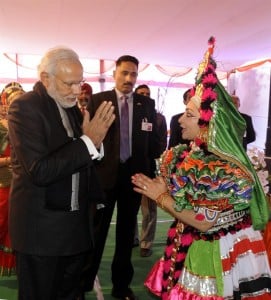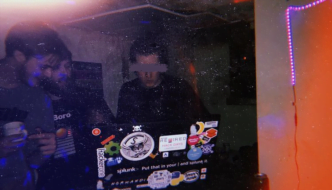YAA DEVI – ‘An Entrancing Spectacle of Power and Subtlety’
June 6, 2015
[Image courtesy of stage.leeds.ac.uk]
South Indian dance is becoming increasingly visible as a mainstream art form in the UK, most recently as a category in the BBC Young Dancer competition – and rightly so. The various styles that make up the genre are compelling narrative art forms that are as technically demanding and emotionally stimulating as their European cousin, ballet. Having watched countless episodes of ‘Dance, India, Dance!’ and been to a few performances whilst living in Rajasthan, when I saw Ya Devi on the Stage@Leeds programme I was very keen to see something in my own local environment.
However, as I took my seat amongst the sari and salwar-clad audience members and the house lights went down, Leeds simply faded away. Devika Rao and her fellow artists (Manuela Benini, Prem Rai, Anindita Adhikary and Bavika Sethi) materialised in pools of soft, coloured light, and immediately the divine themes of the performance became apparent. From their gently undulating tableau, the dancers dominated the space and established a powerful presence which they maintained throughout the piece. In the hour that followed, the troupe transported the theatre and everyone in it from Brazil to India, stopping off at Nepal and Roman Italy on the way, telling the tales of some of mythology’s most eminent goddesses in an exploration of female strength and sensitivity.

[Image courtesy of devikarao.com]
The dancers moved easily between classical South Indian dance styles, including Kathak, Bharatanatyam, Odissi, Kuchipudi and Yakshagana, at times imbued with notes of contemporary. The result was a diverse programme, moving effortlessly from soft piety to aggressive militarism. The performers’ mastery of their own bodies allowed them to transition between the different moods, adapting the level of physical and emotional tension to embody the stories and music that has inspired their work. Regardless of the tone of the individual pieces, the dancers maintained their elegance, precision and musicality throughout the whole performance.
Accompanied by an impressive score created by Praveen D Rao, the dancers carried their own percussive lines thanks to their footwork, bells and jewellery. It was a shame that there was no live music, as the dynamic relationship between dancer and musician is particularly pronounced in South Asian dance, and an opportunity to take the performance up a level was perhaps missed. Nonetheless, the score was ideally suited to the narrative, and it the level of collaboration between choreography and composition was clear.
The set was minimal, but this was by no means a bad thing, as the lighting was sufficient to the set the mood, and the dancers’ costumes gave clues to the location of the story. The costumes themselves were stunning, a myriad of colours and textures and bedecked with jewellery and garlands, but in no way overpowering. The whole piece was set off by projections at the back of the stage, adding to the overall atmosphere of intrigue and drama. All in all, the performance was an entrancing spectacle of power and subtlety, and clearly demonstrated the passion of all the dancers involved.
Philippa Watts
Find out more about the YAA DEVI tour.




Comments